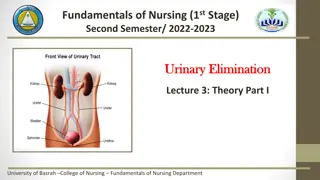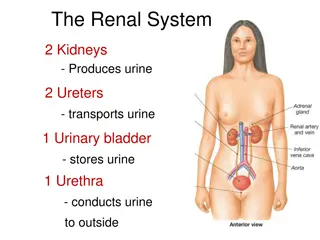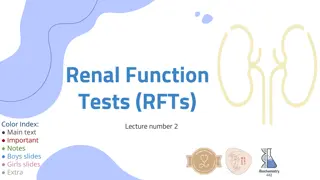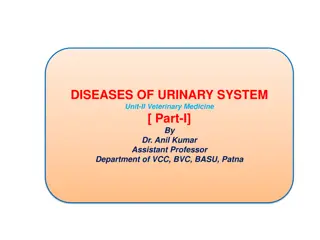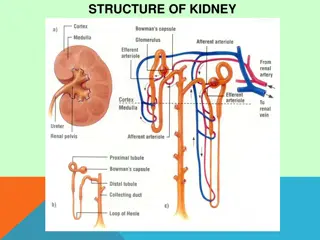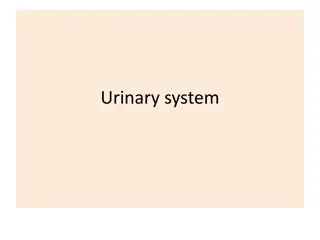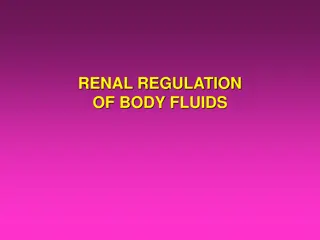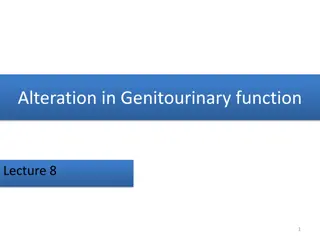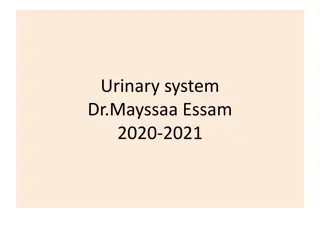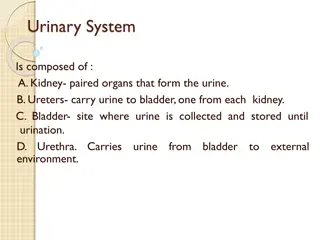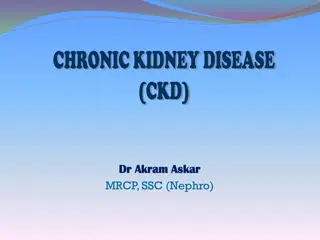Urinary Elimination: Anatomy, Physiology, and Function of the Kidneys
The lecture covers the fundamentals of urinary elimination focusing on the kidneys' location, structure, function, and the role of nephrons. It discusses the transport of urine through the ureters to the bladder, highlighting the bladder's muscle layers and the urethra's role in expelling urine. Stu
6 views • 37 slides
An Overview of the Renal System and Nephron Anatomy
The renal system consists of the kidneys, ureters, urinary bladder, and urethra, responsible for producing, transporting, storing, and excreting urine. The kidneys are surrounded by three layers, and the nephron is the functional unit responsible for filtering blood and producing urine. Key componen
5 views • 26 slides
Renal Function Tests: Lecture Insights on Kidney Function and Structure
This lecture delves into the essential aspects of renal function tests, exploring the functional units of the kidney, the role of nephrons in maintaining homeostasis, and the intricate processes of filtration, reabsorption, and secretion within the renal tubules. Key topics include the hormonal and
4 views • 17 slides
Urinary System Function in Veterinary Medicine
The urinary system in veterinary medicine involves the anatomy and physiological functions of maintaining body fluid composition and volume. Key processes like urine production, filtration, reabsorption, and regulation through nephrons play vital roles in maintaining overall health. This article cov
1 views • 14 slides
Kidney Function and Laboratory Tests
This article delves into the structure and function of the kidneys, specifically focusing on nephrons and the implications of nephron loss. It also discusses the importance of blood urea and serum creatinine tests in evaluating kidney function, highlighting the differences between the two and their
3 views • 44 slides
Renal Block Pathology Practical: Anatomy and Histology Overview
The Renal Block Pathology Practical provides a comprehensive insight into the anatomy, structure, and histology of the kidney nephrons, including normal and abnormal conditions such as acute kidney injury. The session covers topics like the structure of the nephron, normal kidney gross anatomy, rena
4 views • 47 slides
Nephritis: Causes, Symptoms, and Subtypes
Nephritis is a serious medical condition characterized by inflammation of the nephrons in the kidneys. This inflammation can lead to various subtypes such as glomerulonephritis and interstitial nephritis, each with its own causes and symptoms. Common symptoms of nephritis include edema, changes in u
0 views • 26 slides
Urinary System: Kidneys, Functions, and Structure
The urinary system, also known as the renal system, consists of the kidneys, ureters, bladder, and urethra. Each kidney contains nephrons, the functional units responsible for filtering waste and regulating blood volume, pressure, electrolytes, and pH balance. The kidneys have an extensive blood sup
0 views • 35 slides
Renal Regulation of Body Fluids
Renal regulation of body fluids involves mechanisms like water diuresis and osmotic diuresis to maintain fluid balance in the body. The secretion of Anti-Diuretic Hormone (ADH) plays a crucial role in controlling water retention. ADH release is influenced by factors like blood volume, blood pressure
0 views • 18 slides
Alterations in Genitourinary Function: An Overview
The genitourinary system comprises the urinary and reproductive organs, with the kidneys, ureters, bladder, and urethra playing crucial roles. Maintaining proper function involves factors like renal blood flow, glomerular filtration, tubular function, and urine flow. Nephrons are the functional unit
0 views • 58 slides
Kidney Physiology and Function in the Human Body
Kidneys play a crucial role in regulating arterial blood pressure, erythrocyte production, glucose synthesis, and filtration through nephrons. They cannot regenerate nephrons, leading to a gradual decrease in function with age. Key structures like the hilum, renal artery, and vein, as well as the ne
0 views • 127 slides
The Canine Urinary System: Functions and Parts Explained
Explore the intricate details of the dog's urinary system, including the kidneys, nephrons, ureters, urinary bladder, and urethra. Learn how these components work together to maintain proper waste filtration and blood circulation. The images provided offer a visual guide to aid in understanding the
0 views • 6 slides
Overview of the Urinary System and Kidney Function
The urinary system, also known as the renal system, includes the kidneys, ureters, bladder, and urethra. Its main functions are waste elimination, blood volume regulation, electrolyte control, and pH regulation. The kidneys, bean-shaped organs with a complex structure, filter blood to produce urine.
0 views • 35 slides
The Human Urinary System
The human urinary system consists of the kidneys, ureters, bladder, and urethra. The kidneys filter blood to produce urine, which is carried to the bladder through the ureters for storage until excretion. Each kidney is structured with renal pyramids and nephrons for blood filtration and waste remov
0 views • 16 slides
CHRONIC KIDNEY DISEASE
Chronic Kidney Disease (CKD) is a progressive condition leading to irreversible loss of renal function. This involves stages categorized by Glomerular Filtration Rate (GFR), ranging from mild kidney damage to kidney failure requiring dialysis or transplant. The pathophysiology of CKD involves loss o
0 views • 33 slides
Fundamentals of Nursing
Kidneys play a vital role in maintaining body fluids by filtering waste and forming urine. Nephrons, the functional units of kidneys, regulate fluid balance through reabsorption and secretion. The urine then travels from kidneys to the bladder through the ureters, where it is stored until eliminatio
0 views • 16 slides
